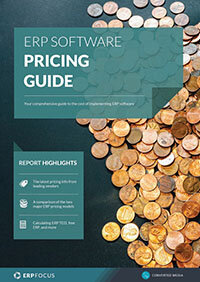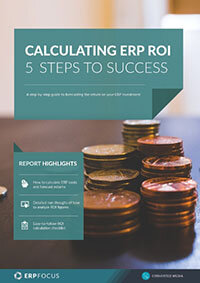Benefits of ERP for reducing inventory holding costs
This article is one in a series of using ERP to reduce costs. A previous article looked at reducing purchasing costs and subsequent ones will consider manufacturing and administration costs; finishing off with approaching the issue from a slightly different angle and looking at using ERP to increase profitability. But this one looks at inventory costs.
ERP inventory
Inventory is expensive. It is expensive to buy and to make, it is expensive to hold and, when there is too much of it, it is expensive to write off. Nevertheless, holding some stock is almost always necessary, whether finished items/SKUs, intermediates or raw materials, in order to ensure that acceptable lead times can be offered to customers. Good inventory management is a delicate balance between availability and cost, but for many years Inventory Controllers had very few aids to achieve that balance. In fact, few companies had much more than Reorder Point (ROP) control and the Economic Order Quantity (EOQ) calculation and, whilst these remain valid options in some environments even today (being the basis of Kanban), they both have flaws and limitations.
Reorder Point control (ROP)
Looking at ROP first; a challenge is that it has to be set sufficiently high to ensure that stock on-hand when it is breached, and a replenishment order is raised, is sufficient to last until those replenishments arrive. That requires two things: that the replenishment lead time is known and reliable, and that demand within the replenishment horizon is equally know and predictable. If not, there will either be a shortage or an excess. Calculating ROP using worst case scenarios, or holding safety stock to cope with variances, can work but can be expensive.
Economic Order Quantity (EOQ)
Turning to EOQ (a technique first expounded in 1917); a problem here again is that it works on the assumption that, as far as demand goes, the future will be the same as the past, so will be both stable and predictable. But there are also problems with the calculation itself because it relies on two values that are frequently inaccurate or unknown: the cost of placing an order and the cost of carrying inventory. Although many books specify the calculation, they firstly don't define what the cost of ordering is: does it just include raising and placing the order or does it include things like the cost of inspection and the cost of unloading and putting away? (And the cost of unloading 20 pallets of material will be greater than the cost of pumping material from a tanker to a silo.)
Inventory carrying cost
Turning to the inventory carrying cost; most companies use either the cost of borrowing from the bank to finance that stock or the interest percentage that money would earn in the bank if it wasn't in the warehouse.
The Society of Cost Management has calculated that the true cost of holding stock can vary from 18% right through to 35%, depending on circumstances. Even the lower figure can come as a shock, so it may be worth looking at their figures for what they regard as a typical company:
- 15% Opportunity cost (i.e. what would you do with that money if you had it in cash and not stock?
- 4% Storage costs
- 2.1/2% Tax (inventory is viewed as an asset)
- 1% Obsolescence and spillage
- 1% Shrinkage and damage
- 0.5% Insurance
Obviously, these figures will vary from country to country, and even from time to time, but it is clear that more than just the cost of money needs to be considered when calculating inventory holding costs.
Benefits of ERP for inventory
As manufacturing, and the products being manufactured, became more complex, ROP and EOQ became, in many industries, less and less effective and eventually, Materials Requirements Planning (MRP) was developed as an alternative; evolving through Materials Resource Planning (MRPII) to be an integral part of every full-functionality ERP system today. MRP can cope with uneven demand and varying lead times although it is not unusual to see ROP/EOQ and MRP co-existing or even combined in a hybrid solution.
The big advantage of MRP, though, is that it can schedule replenishments precisely and so it can bring in exactly what is required, and no more, exactly when it is required. Even if it has to be fed by a sales forecast that cannot hope to be 100% accurate, it can net-off overages in one planning period against demand in the next.
Moving to work in progress (WIP) reduction, Little's Law becomes useful:
WIP = throughput rate (units per given period of time) * throughput time (lead time)
So, for example, if the line (or machine or department) is turning out 100 units an hour and it takes 5 hours for an item to progress from the beginning of the line to the end, then there will be on average 100 x 5 = 500 items on the line (i.e. in WIP) at any one time.
The throughput rate of a production line can generally only be increased by investing in new plant or by speeding up the line, which will require more operatives. Either of these options will have a cost which probably cannot be covered by the reduced WIP cost. (Of course, if sales are being restrained by a lack of product, the increased cost may be justifiable.) Which leaves throughput time.
In order to reduce WIP, the amount of time that it takes to get jobs through a work center must be reduced. It is important to remember that throughput time (or lead time) is not just processing time: it includes time when the items are in a queue awaiting their turn to be processed. So when companies reduce queue time they reduce throughput time, and Little's Law says that if they reduce throughput time they will reduce WIP. There are several ways that ERP can help to reduce queue time, of which removing unnecessary work from the queue and improving production scheduling are generally the most useful.
Removing unnecessary work from the queue
In a batch manufacturing environment, items in the queue are almost always items that are genuinely required, but the quantities being made frequently are not. If EOQs are not accurate, they can generate requirements beyond those that are actually required in the short term. And, as has been mentioned, an ERP system can recalculate EOQs both regularly and automatically.
Improved production scheduling
Most companies by now have learned that just pushing more into the factory doesn't guarantee that more will come out. What actually happens is that overloading the factory causes logjams and, when several jobs arrive at a Work Center simultaneously, it is almost impossible to know which should have priority. The result is obvious.
But ERP systems offer three tools to help alleviate the problem: Master Production Scheduling, Rough Cut Capacity Scheduling and Finite Capacity Scheduling. Full-function ERP systems offer the option of running production from a Master Production Schedule (MPS) and, in a mature organization, this is signed-off by Production, Sales and Finance because it affects all of these. It is obviously important for Production to know that they have a realistic production plan but it is important also for Sales and Finance. It is important for Sales because it will be the basis for delivery promises and it is important for Finance because the MPS drives material replenishment and an over-ambitious (“The more you ask for; the more you'll get”) plan will result in a significant rise in both raw material and WIP stocks when jobs simply cannot be processed in time.
A realistic MPS is the beginning of solving these problems and it can either be manually created or it can be calculated by the system, using rules that it has been given, for subsequent manual review and, if necessary, adjustment. Traditionally the validity of the MPS was first tested by running it through an RCCP (Rough Cut Capacity Planning) system but in recent years this has been criticized because many people don't understand what RCCP is. The criticism is that it assumes infinite capacity but that is actually its strength: a finite capacity scheduler (FCS) will first try to reschedule jobs to fit existing capacity but not all companies work 24/7 and the first thing that they want to do is to see if capacity restraints can be overcome but working some overtime.
It is true, however, that the cost of FCS systems, and hardware sufficiently powerful to enable them to run quickly, has now dropped to levels that allow most companies to by-pass the RCCP stage and go straight to FCS (and to adjust the plan there) but it remains a good option for many. FCS gets into more detail than RCCP and allows production schedules to be optimized. That can make a real difference to costs, and throughput when capacity is limited and when many inter-connected manufacturing resources have to be planned (just putting 8 jobs through one work center can be done in (8x7x6x5x4x3x2x1)= 40,320 different sequences. Although good planning staff usually have a feel for the optimum sequence at any particular resource, in complex manufacturing environments getting just a few percent extra out of the factory can make a big difference to the bottom line.
ERP offers many options that were not available just a few years ago and taking the time to research and review them by, for example, checking out the blogs on this website will be time well spent.
Free white paper

ERP Software Pricing Guide
Get the latest pricing information on over 80 popular ERP systems, and learn how to budget for your ERP project in our free guide

Featured white papers
-

Calculating ERP ROI: 5 steps to success
Calculate your new ERP's financial benefits with this comprehensive guide
Download
Related articles
-

What are the benefits of manufacturing ERP?
The advantages of ERP for manufacturing businesses
-

Secret KPI: Why Your ERP Implementation Team Matters More Than Software
Learn how Godlan ensures successful ERP implementation for manufacturers with proven strategies &...
-

Top 10 ERP selection criteria (including checklist)
The most important ERP selection criteria you should keep in mind during your selection process.

